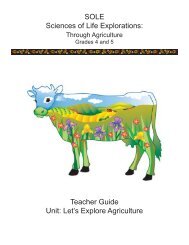Insect Anatomy - Agriculture in the Classroom
Insect Anatomy - Agriculture in the Classroom
Insect Anatomy - Agriculture in the Classroom
You also want an ePaper? Increase the reach of your titles
YUMPU automatically turns print PDFs into web optimized ePapers that Google loves.
9.<br />
Class discussion<br />
A. What are <strong>the</strong> characteristics of <strong>in</strong>sects<br />
B. They have three ma<strong>in</strong> parts (head, thorax, and abdomen)<br />
C. They have a pair of feelers on <strong>the</strong> top of <strong>the</strong>ir head called antennae<br />
D. They have 6 jo<strong>in</strong>ted legs. Some use <strong>the</strong>ir legs for jump<strong>in</strong>g, swimm<strong>in</strong>g, or grasp<strong>in</strong>g<br />
E. Instead of sk<strong>in</strong> <strong>the</strong>y have an outer cover<strong>in</strong>g called an exoskeleton<br />
F. <strong>Insect</strong>s can have two sets of w<strong>in</strong>gs, one set of w<strong>in</strong>gs, or no w<strong>in</strong>gs at all.<br />
Teacher Background:<br />
(For related activities refer to student worksheets #3 through #7)<br />
BODACIOUS BUGS<br />
Adapted from http ://www.saxarts.com/resources/lessonPlans/bodaciousBugs.jsp<br />
The shapes of <strong>in</strong>sects are fasc<strong>in</strong>at<strong>in</strong>g. There are many wonderful features about <strong>in</strong>sects that give <strong>the</strong>m <strong>the</strong>ir<br />
abilities <strong>in</strong> flight and survival. The body of an adult <strong>in</strong>sect has 3 ma<strong>in</strong> parts - <strong>the</strong> head, <strong>the</strong> thorax (chest) and<br />
<strong>the</strong> abdomen. Almost all adult <strong>in</strong>sects have a pair of feelers or antennae at <strong>the</strong> front of <strong>the</strong> head. Every adult<br />
<strong>in</strong>sect has six legs and most of <strong>the</strong>m have one or two pairs of w<strong>in</strong>gs. The thorax is <strong>the</strong> locomotion center. It is<br />
packed with powerful muscles which operate <strong>the</strong> <strong>in</strong>sect’s 6 legs as well as its w<strong>in</strong>gs.<br />
An adult <strong>in</strong>sect wears its skeleton on <strong>the</strong> outside, <strong>in</strong> <strong>the</strong> form of a hard outer coat<strong>in</strong>g. This tough shell is light<br />
enough not to prevent <strong>the</strong> <strong>in</strong>sect from fly<strong>in</strong>g. The exoskeleton also acts like a ra<strong>in</strong>coat and keeps water from<br />
soak<strong>in</strong>g <strong>in</strong>to <strong>the</strong> body. It keeps <strong>the</strong> body from los<strong>in</strong>g water. It helps <strong>the</strong> <strong>in</strong>sect live and fly through long dry or ra<strong>in</strong>y<br />
spells. It also protects <strong>the</strong> <strong>in</strong>sect from some of its enemies.<br />
Materials:<br />
Pictures of various <strong>in</strong>sects<br />
Scissors<br />
Pipe cleaners<br />
Craft fea<strong>the</strong>rs<br />
Plastic beads<br />
Sequ<strong>in</strong>s<br />
Glue<br />
Craft wire<br />
Procedure:<br />
1. Exam<strong>in</strong>e a picture of an <strong>in</strong>sect. How big are <strong>the</strong><br />
abdomen and thorax How many legs does it have<br />
What shape are <strong>the</strong> w<strong>in</strong>gs Have student make a small<br />
draw<strong>in</strong>g as a guide.<br />
2. To beg<strong>in</strong>, cut a pipe cleaner <strong>the</strong> entire length of <strong>the</strong><br />
<strong>in</strong>sect. This will act as a base which o<strong>the</strong>r elements can<br />
be added to.<br />
3. W<strong>in</strong>d pipecleaners around <strong>the</strong> base to create <strong>the</strong><br />
three ma<strong>in</strong> parts of <strong>the</strong> <strong>in</strong>sect (head, thorax, and<br />
abdomen).<br />
4. Cut fea<strong>the</strong>rs to size and stick <strong>the</strong> enda <strong>in</strong>to <strong>the</strong> wound<br />
pipecleaners as w<strong>in</strong>gs. Add a drop of glue to secure.<br />
5. Glue beads on <strong>the</strong> head of <strong>the</strong> <strong>in</strong>sect for eyes. Sequ<strong>in</strong>s<br />
make wonderful compound eyes.<br />
6. If antennae are needed, <strong>the</strong>y will stick out best if <strong>the</strong><br />
wire is embedded or wound <strong>in</strong>to <strong>the</strong> pipecleaner at <strong>the</strong> head. Craft wire can be used for delcately shaped<br />
antennae.<br />
7. When <strong>the</strong> <strong>in</strong>sects are completed <strong>the</strong>y can be hung around <strong>the</strong> classroom for display.<br />
(For Image: related www.saxarts.com/resources/lessonPlans/<br />
activities refer to student worksheets #2, #6, & #7)
















